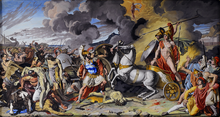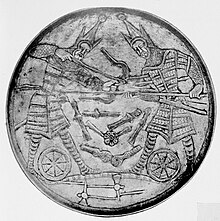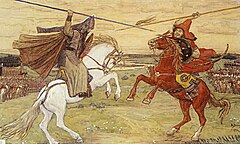Single combat

Single combat is a duel between two single combatants which takes place in the context of a battle between two armies.
Instances of single combat are known from
Typically, it takes place in the
Single combat could also take place within a larger battle. Neither
Antiquity

An important episode in "
Duels between individual warriors are depicted in the Iliad, including those between Menelaus and Paris and later between Achilles and Hector. The Hebrew Bible also includes a few accounts of single combat, the most famous being David versus Goliath.
Single combat is mentioned quite frequently in the history of
Depictions of single combat also appear in the Hindu epics of the
Middle Ages
According to the Byzantine historians Nikephoros and Theophanes the Confessor, during the Battle of Nineveh - climactic battle of the Byzantine–Sasanian War of 602–628 - the Persian general Rhahzadh challenged the Byzantine Emperor Heraclius to single combat with the hope of forcing the Romans to flee. Heraclius accepted the challenge and spurred his horse forward and with a single blow struck off Rhahzadh's head, taking from the dead Persian his shield of 120 gold plates and gold breastplate as trophies. With Rhahzadh's death perished the Persians' hopes of victory: seeing their brave commander and many other high-ranking officers being slain by Heraclius and his household troops, the Persian troops lost heart and were slaughtered suffering around 6,000 casualties.[2][3][4]
In magician Gwydion, to determine the victor of a war between the two kingdoms.
Many battles depicted in the medieval
An important episode in Geoffrey of Monmouth's legendary History of the Kings of Britain is the single combat between prince Nennius of Britain and Julius Caesar.
Single combat was also a prelude to battles in pre-
Single combats were characteristic of the
In Russia, single combat is known as bash na bash (an old Russian expression meaning "one-on-one"), substituting a fight between champions for a full-scale battle was a traditional way to avoid the bloodshed of an internecine war. The leaders of the opposing druzhinas or other armed groups either rode towards the centre of the battlefield or sent messengers to negotiate whether the two most skilled fighters or the leaders themselves would engage in single combat, usually to the death. The outcome of the champions' fight would then be taken as a sign of which side the higher powers favoured, and could have political consequences similar to the result of a full battle.
The oldest written account of such a fight is found in
The semi-legendary Tale of the Destruction of Ryazan includes an extensive account of the combat between the Russian hero Evpaty Kolovrat and the Tatar warrior Hostovrul. Kolovrat splits his opponent in half with his sword and wins the duel. However, Kolovrat is then attacked and killed from a distance by Tatar stone throwers. The Mongol ruler Batu Khan, impressed with his bravery, honours his body.

Sometimes however, such single combat would merely initiate a battle rather than prevent it. The most famous example of this was the duel between Russian monk Alexander Peresvet and the Golden Horde champion Chelubey or Temir-Murza at the beginning of the Battle of Kulikovo in 1380. The champions killed each other in the first run, though according to Russian legend, Peresvet did not fall from the saddle, while Temir-Murza did.
In Kerala, India, duelling between warriors was used to settle conflicts between local rulers. The prime martial caste of Kerala,
In Southeast Asia, formal elephant duels were sometimes contested between opposing army leaders to determine the outcome of a conflict, in lieu of full-on fighting by their armies.[7]
Modern examples
Captain
Dramatist Ben Jonson, in conversations with the poet William Drummond, recounted that when serving in the Low Countries as a volunteer with the regiments of Francis Vere, he had defeated an opponent in single combat "in view of both armies" and stripped him of his weapons.[9]
In more recent times, single combats have become iconic – though often apocryphal – elements of aerial dogfights, with the idea, if not the practice, of single combat in the skies particularly prevalent during the First World War with the air forces' emphasis on a sort of individualism and chivalry. Manfred von Richthofen, the infamous "Red Baron", is recorded as writing "If I am alone with an opponent ... only a jammed gun or an engine problem can prevent me from shooting him down."[10]
See also
- Duel
- Hand-to-hand combat
- History of fencing
- Mard o-mard
- Wager of battle
References
- ^ Mode, M. (2006). Heroic fights and dying heroes. The Orlat battle plaque and the roots of Sogdian art. Ēran ud Anērān. Studies Presented to Boris Il’ič Maršak on the Occasion of His 70th Birthday (Venezia 2006), 419-454.
- ^ Cite error: The named reference
Kaegi167was invoked but never defined (see the help page). - ^ Cite error: The named reference
Norwich93was invoked but never defined (see the help page). - ^ Konieczny, Peter (June 5, 2016). "Single Combat? The Duel between Heraclius and Razhadh at the Battle of Nineveh". Karwansaray Publishers. Retrieved February 5, 2018.
- ^ "Sunan Abu Dawud: Book 14, Number 2659". Usc.edu. Archived from the original on 2011-02-10. Retrieved 2010-05-30.
- ISBN 978-90-04-33794-7.
- ^ Terwiel, Barend Jan (2013). "What Happened at Nong Sarai? Comparing Indigenous and European Sources for Late 16th Century Siam". Journal of the Siam Society. 101: 19–34.
- ^ Not Just Another John Smith, usnews.com, January 21, 2007
- ^ Drummond, William (1619). Heads of a conversation betwixt the famous poet Ben Johnson and William Drummond of Hawthornden, January 1619.
- ISBN 9780815333517. Retrieved 2014-10-18.
External links
 Media related to Single combat at Wikimedia Commons
Media related to Single combat at Wikimedia Commons- Champions and Tradition: Single Combat in the Late Roman World
